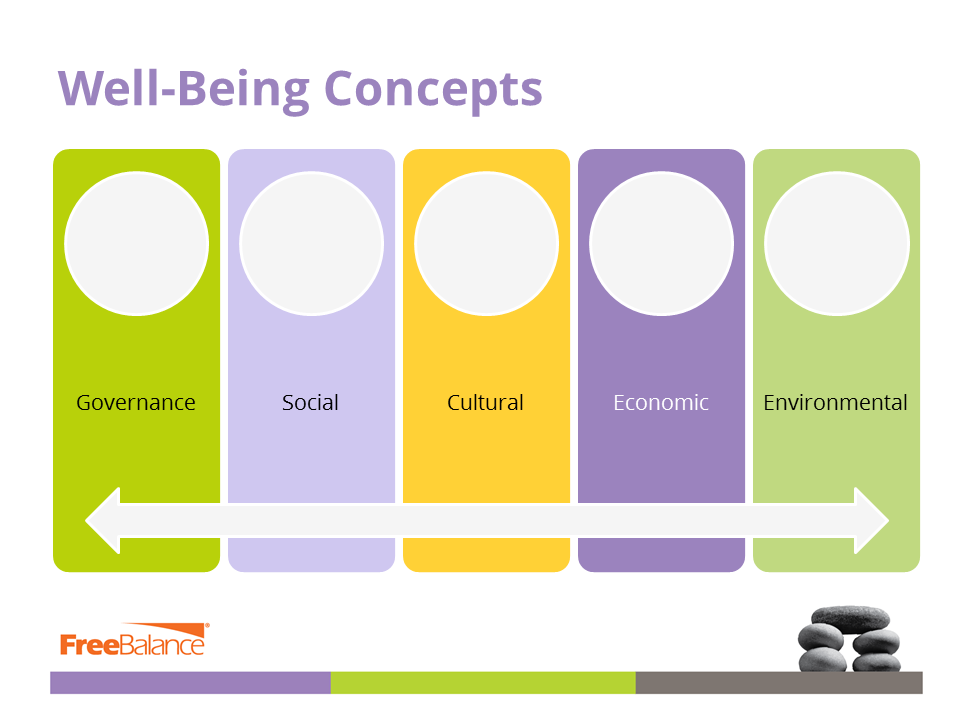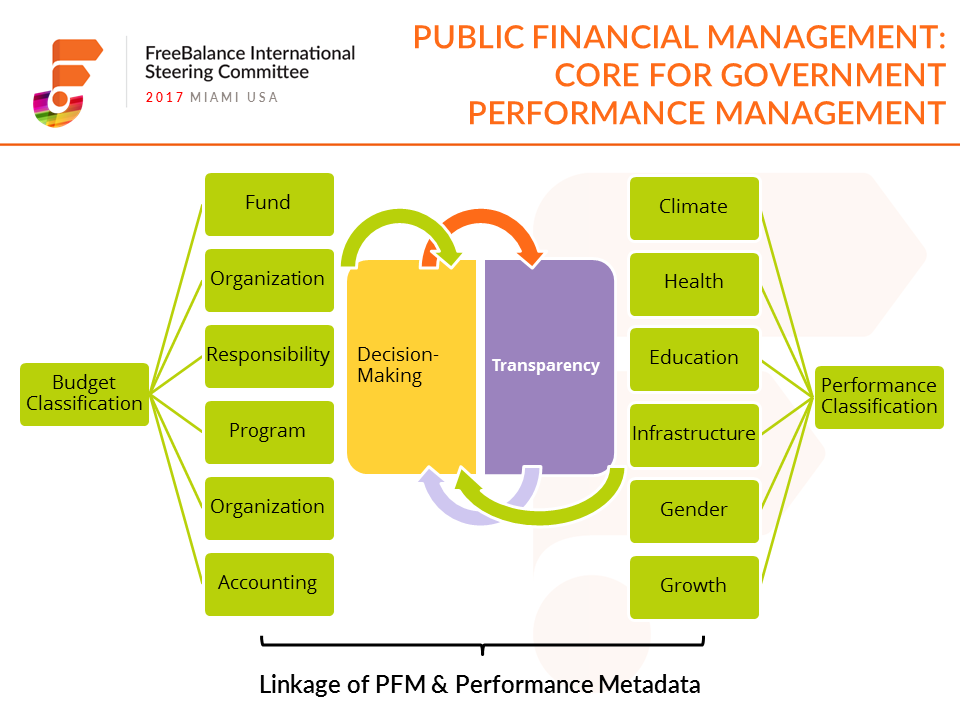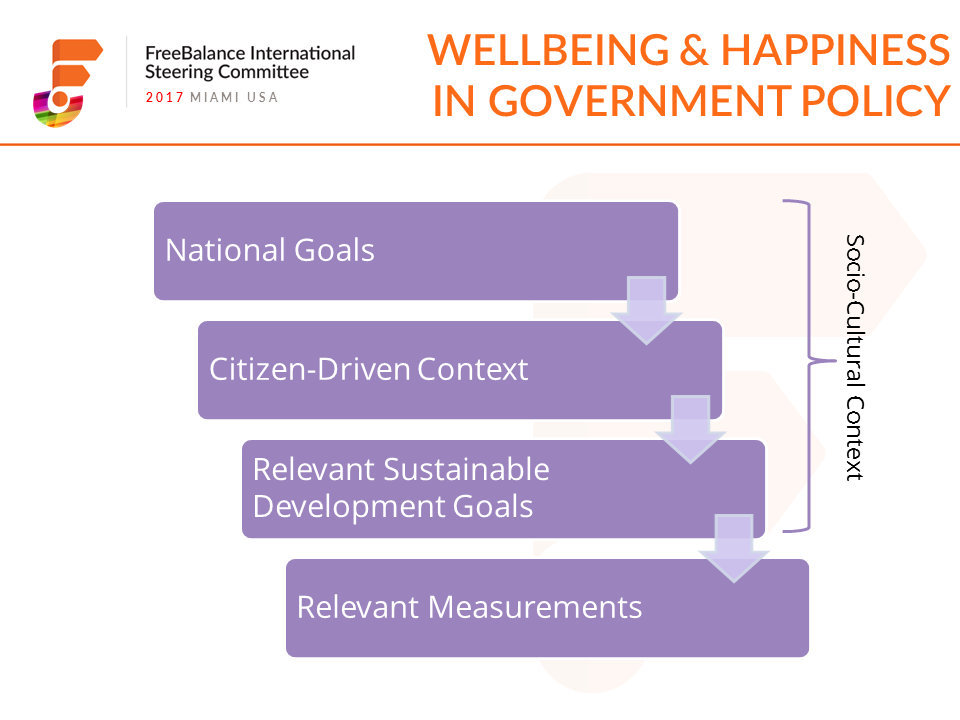Members of the FreeBalance International Steering Committee (FISC) provided insight into the use of the balanced scorecard in government for happiness and wellbeing last month in Miami. The previous blog entry described how the balanced scorecard perspectives were adapted to meet government objectives. The basic template, shown above was provided.
Why simplify policy-making?
Governments who measure happiness and wellbeing can better align policy with citizen needs. The public policy spectrum is complex.

Government policy operates in an environment of many inputs. Policy-makers attempt to align government goals with changing economic realities. The conflict between short-term and long-term interventions is further complicated by real sectoral needs and bureaucratic incentives. Meanwhile, external stakeholders attempt to influence policy. Budgets are developed based on policy. However, this does not stop the impact of changing sectoral needs or external stakeholder pressure.

Policy execution is further complicated by the organizational structure of government. Many Ministries, Departments and Agencies (MDAs) could be involved in a single sector. Many MDAs could be involved in programs for one or more sectors. The impact of interventions can be compromised or enhanced through the involvement of multiple government organizations.
Government complexity means that spending outcomes are difficult to measure, especially given compromises made throughout the policy and budgeting process.
How can performance management techniques, like the balanced scorecard, simplify policy-making?
As described in a previous post, the balanced scorecard can:
- Provide relevant outcome measurements for the public sector that does not have the bottom line of profit to measure performance
- Scale and cascade performance measures to all government organizations in a consistent manner
- Reduce scope complexity and provide accountability incentives
How can the happiness and wellbeing balanced scorecard aid governments in achieving the Sustainable Development Goals (SDGs)?
The introduction of SDGs and happiness measures could be interpreted as complicating policy-making. Governments who realize that SDGs and happiness should change prioritization methods will see simplification in policy-making. Those governments that recast current prioritization methods as SDGs or happiness will find no advantage. And, those governments that add SDGs and happiness to prioritization methods will complicate an already complex process.
There are consistent happiness and wellbeing themes that align with policy concepts:
- Governance concepts like effectiveness, anti-corruption, rule of law, and accountability used as World Governance Indicators
- Social concepts such as education, health, age and gender
- Cultural concepts such as religion, family, art and music
- Economic concepts such as growth, income, and economic sectors
- Environmental concepts such as pollution, resource usage, and climate change

These five concepts align well with the SDGs.

The process of aligning national goals with SDGs and policy is simplified through categorization:
- National goals are identified and categorized through
- Happiness and wellbeing measures that identify the governance, social, cultural, economic and environmental context that prioritizes
- Sustainable Development Goal objectives and identifies
- Balanced scorecard key performance indicators that are shared and cascaded throughout government MDAs
![FreeBalance International Steering Committee - Wellbeing & Happiness in Government Policy]() Why is categorization and metadata critical to achieve balanced scorecard success in Government?
Why is categorization and metadata critical to achieve balanced scorecard success in Government?
Governments utilize numerous classifications to assist in management. There are salary scale structures, asset classes, financial coding blocks, and vendor classifications. The addition of performance structures and the 17 SDGs can complicate management. FreeBalance government customers have found that consistent metadata structures built on budget classifications, or the “chart of accounts”, provides the basis for effective management.

The Chart of Accounts (COA) can be configured in modern Government Resource Planning (GRP) software to reflect budget and performance classifications. The COA coding block encapsulates budget, organizational, purpose, program, and performance information. And, that structure can be simplified for day-to-day data entry, while decision-makers can track progress on SDGs and government objectives.
The balanced scorecard provides a performance structure through a logic map that typically identifies up to 20 concepts across the 4 perspectives. A small set of Key Performance Indicators (KPIs) are identified for any concept. The logic map also identifies how a concept from one perspective affects one or more concepts in one or more additional perspectives. This enables governments to create a hierarchical performance structure that is aligned to budgets, and can be cascaded to MDAs and programs.

 Why is categorization and metadata critical to achieve balanced scorecard success in Government?
Why is categorization and metadata critical to achieve balanced scorecard success in Government?